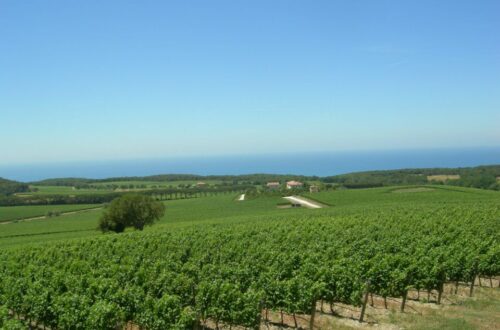Table of Contents
What is Cisterna d’Asti DOC?
Cisterna d’Asti DOC is one of Piedmont’s most intriguing boutique denominations — a small but proud stronghold of Croatina, a grape better known in Lombardy and Emilia-Romagna but here given a distinctly Piedmontese expression. This structured, fruit-forward red captures the rustic charm of the Colline Alfieri, an area bridging the elegance of the Langhe and the vibrancy of Monferrato.
History and Origins
Cisterna d’Asti’s winemaking history stretches back centuries, but it wasn’t until 2002 that the DOC was officially recognized — a nod to the community’s persistence in protecting the Croatina heritage in a region dominated by Barbera and Nebbiolo. The wine has deep rural roots: historically, Croatina was grown in mixed vineyards, blended for family consumption, and celebrated at the Festa dell’Uva harvest festival every September.
Where It’s Made: Geography & Terroir
Nestled between Asti and Turin, the Cisterna d’Asti DOC covers just 11 municipalities, with most vineyards surrounding the medieval hilltop village of Cisterna d’Asti itself. The terroir is shaped by marine-origin soils rich in limestone and clay, creating natural drainage that suits Croatina’s vigor. The continental climate brings hot summers, cold winters, and significant diurnal shifts — conditions that build intense aromatics and firm tannins.
The Grape: Croatina
In Piedmont, Croatina is sometimes mistakenly called Bonarda — but it is genetically distinct. Croatina produces wines that are deeply colored, with ripe blackberry and plum flavors, floral undertones, and a firm tannic backbone. In Cisterna d’Asti, it often shows a more restrained alcohol level and fresher acidity than in Oltrepò Pavese or Valtellina, making it both food-friendly and cellar-worthy.
Winemaking & DOC Regulations
Under DOC rules, Cisterna d’Asti wines must contain 85–100% Croatina (up to 15% other local red grapes permitted). Minimum alcohol is 11.5%, with a minimum aging period of 6 months before release. A Superiore designation requires 12 months of aging and 12% minimum alcohol. The style is typically dry, still, and robust, with both stainless steel and barrel maturation used by local producers.
Key Facts at a Glance
| Feature | Detail |
| DOC Established | 2002 |
| Region | Colline Alfieri, Piedmont |
| Grape | 85–100% Croatina |
| Minimum Aging | 6 months (12 months for Superiore) |
| Annual Production | Extremely limited – boutique scale |
| Styles | Dry, still red |
Tasting Notes
Cisterna d’Asti offers a ruby to deep garnet hue, with aromas of blackberries, violets, and subtle spice. On the palate, expect juicy black fruit, hints of licorice, firm but ripe tannins, and a balanced acidity. The finish often carries a touch of almond or earthy minerality.
Serving & Pairing
Serve at 16–18°C (60–64°F) in medium-sized red wine glasses. Ideal with:
- Piedmontese agnolotti del plin
- Roast rabbit (coniglio al forno)
- Aged cheeses like Castelmagno
- Mushroom risotto
Where to Buy & Pricing
Production is limited, so availability outside Italy is scarce. Expect prices between €12–20 in Italy and $25–35 internationally. For sourcing:
- Wine-Searcher
- Producer websites (see below)
Producer Directory
- Tenuta La Pergola – Sustainable practices, offers guided tastings.
- Cantine Povero – Historic family estate with agriturismo.
- Cirlin de Paolo – Artisan-scale, minimal intervention approach.
Cisterna vs. Other Boutique DOCs
| DOC | Main Grape | Character | Production Scale |
| Cisterna d’Asti | Croatina | Fruity, tannic, fresh acidity | Very small |
| Verduno Pelaverga DOC | Pelaverga Piccolo | Peppery, light-bodied | Small |
| Carema DOC | Nebbiolo | Elegant, alpine | Tiny |
Wine Tourism Tips
- Visit during Festa dell’Uva (September) for grape harvest celebrations.
- Combine with Barbera d’Asti DOCG tours for contrast.
- Book tastings in advance — cellar doors are often family-run.
FAQ on Cisterna d’Asti DOC
What makes Croatina different from Bonarda?
They are distinct varieties — Croatina is tannic and age-worthy, while Bonarda (Uva Rara) is softer.
Is Cisterna d’Asti age-worthy?
Yes, especially the Superiore bottlings, which can age 5–8 years.
Where can I taste it in Piedmont?
Primarily in Cisterna d’Asti and neighboring villages; most wineries offer tastings by appointment.
How does it compare to Barbera or Nebbiolo?
Croatina has more tannin than Barbera and less floral elegance than Nebbiolo, but more plush fruit.
Fun Facts & Cultural Notes
- Local legend says Croatina’s deep color made it a “farmer’s Barolo” in hard times.
- The DOC covers only about 50 hectares — smaller than some single estates in Barolo.
Call to Action
💬 Have you tasted Cisterna d’Asti DOC? Share your experience or favorite pairing in the comments — your story could inspire another wine lover’s next discovery.


